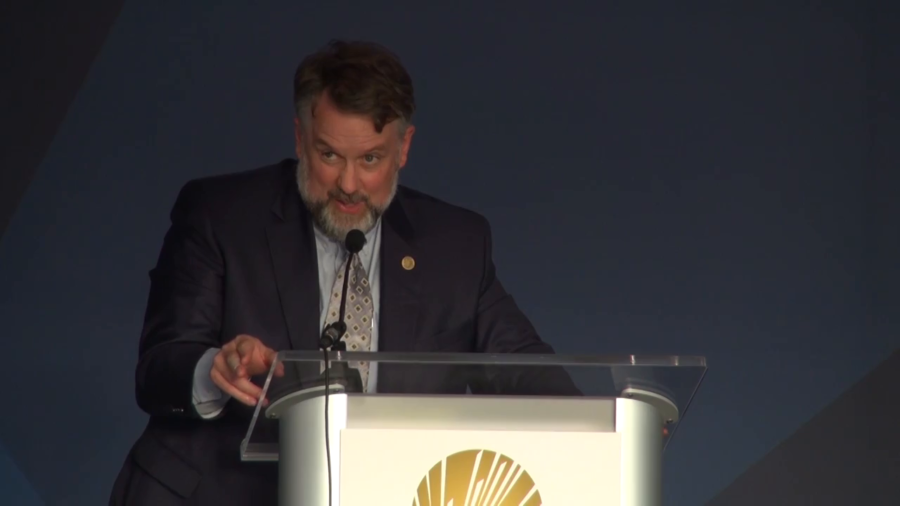Craig Partridge: If you talk with people worried about the evolution of technology one of the things they often comment about is that in many cases the future is quite clear. You can see it coming, but you don’t know how far away it is. Okay. Sometimes it’s quite far away. If some of you have read the early works of Alan Turing you can see that some of the things we’re struggling with in AI today are things that Alan Turing anticipated forty or more years ago.
On the other hand, you also run into situations like the Internet in the 1980s. In that case we could see the future. And it was a series of trains barreling at us at full speed.
At the same time the Internet community was extremely small at that time. And so basically anybody who had the ability to spell “IP” and was eager to actually help out was drafted to fix things. And that’s how I got into this game early on. And in particular, my first step was to discover that the proposed way for routing email using domain names had a bug in it. So I wrote up the bug. I wrote up a solution to it which I will tell you right now was exceptionally ugly. And I sent it to Jon Postel.
And Jon sent me back a note saying, “Why does this look so ghastly?”
And I explained to him it was the only way given the way that DNS have been structured to fix things unless we made some small changes to the DNS.
And he said, “Well let’s make those changes because this is terrible.” And he said, “And since you were smart enough to find the bug, you’re the one who gets to fix it.” Okay.
And then he was kind enough at least to give me some help. He rounded up a few other people to advise me in the process. And so that’s how I ended up being the guy who invented how email is routed. I found the bug and was the stuckee because there wasn’t anybody else. So this is consistent with Ed Krol’s description of the state of the world in the 1980s and early 1990s.
That said I do have a number of people to thank for that and for the later work that I did on high-performance routers and encryption devices, so I want to name a few people. Related to email first of all there’s Jon, who had the confidence to tell somebody who was under 25 at the time that he should be in charge of designing how email was routed. He was very gracious about it, and he stepped in periodically when he thought the committee was getting a little overeager about advising.
I also want to thank Vint Cerf, who played a critical role in helping me learn how to lead technical projects in the years immediately following. Working with Vint is a delight. If anybody gets a chance to work with Vint on a project, do it.
Beyond that Larry Landweber who is here and who taught me the benefit of reaching out internationally at the time when the international Internet community was small but extremely passionate.
Dick Edmiston, my boss at the time who encouraged me to take on the risk. And Dave Crocker, who was always liberal with his advice—and it was usually sound—for those of you who know Dave this will sound very familiar.
After the email routing I went on as I said to work on high-performance routers and encryption devices, and that in itself was also an extremely exciting experience. Building the world’s fastest router at a time that people believed that router technology couldn’t go faster was an extraordinary experience and that only worked because I had a few very extraordinary people who worked with me.
One is a gentleman named Walter Milliken, who probably many of you have never heard of, or if you do you know him from the Steve Jackson games lawsuit many years ago by the EFF. But he is actually one of probably the top four or five people in the world at figuring out how to make hardware and software work together. The kind of guy that says, “No no, you don’t want to make that bit the control bit because it will cause the software to require an interrupt every tenth time you receive something. You don’t want that.” That kind of guy, there are only a few in the world who could do that. Other people are folks like the late Chuck Thacker. Walter was one and saved me on both encryption devices and routers from making many mistakes.
Beyond that, Dr. Steve Kent who’s also a member of the Internet Hall of Fame and who helped in many of the hard problems on the high-performance encryption devices.
More generally, it has been a great privilege to work at BBN. BBN turned on the ARPANET in 1969 and it has retained a long tradition of extremely high-quality networking people so you can stroll down the hall anytime with a challenge and find someone who’s happy to give you an opinion, usually a very good one, about how to make your work better.
And I want to thank obviously my family, my parents, my sister, my son, for their support, particularly since it means I’m usually not around. I’m on a plane somewhere to work with other people related to the Internet. And I want to thank the ISoc for this tremendous honor. So thank you very much.
